Analysis of Organizational Theories, Leadership, and Planning
VerifiedAdded on 2021/04/17
|10
|2844
|74
Report
AI Summary
This report provides an in-depth analysis of organizational theories and leadership styles, including ERG theory, two-factor theory, democratic leadership, and charismatic leadership. It examines how these theories are applied in organizations like Fisher & Paykel Healthcare and Fonterra. The report also explores delegation of authority, change models (Lewin's change model and the white water metaphor), and external forces that drive organizational change. Furthermore, it delves into strategic planning processes, including SWOT analysis, and the importance of control cycles, using the Simunovich Olive Estate as a case study. The report emphasizes the importance of planning processes and the application of these concepts in real-world business scenarios, offering valuable insights for understanding and managing organizations effectively.
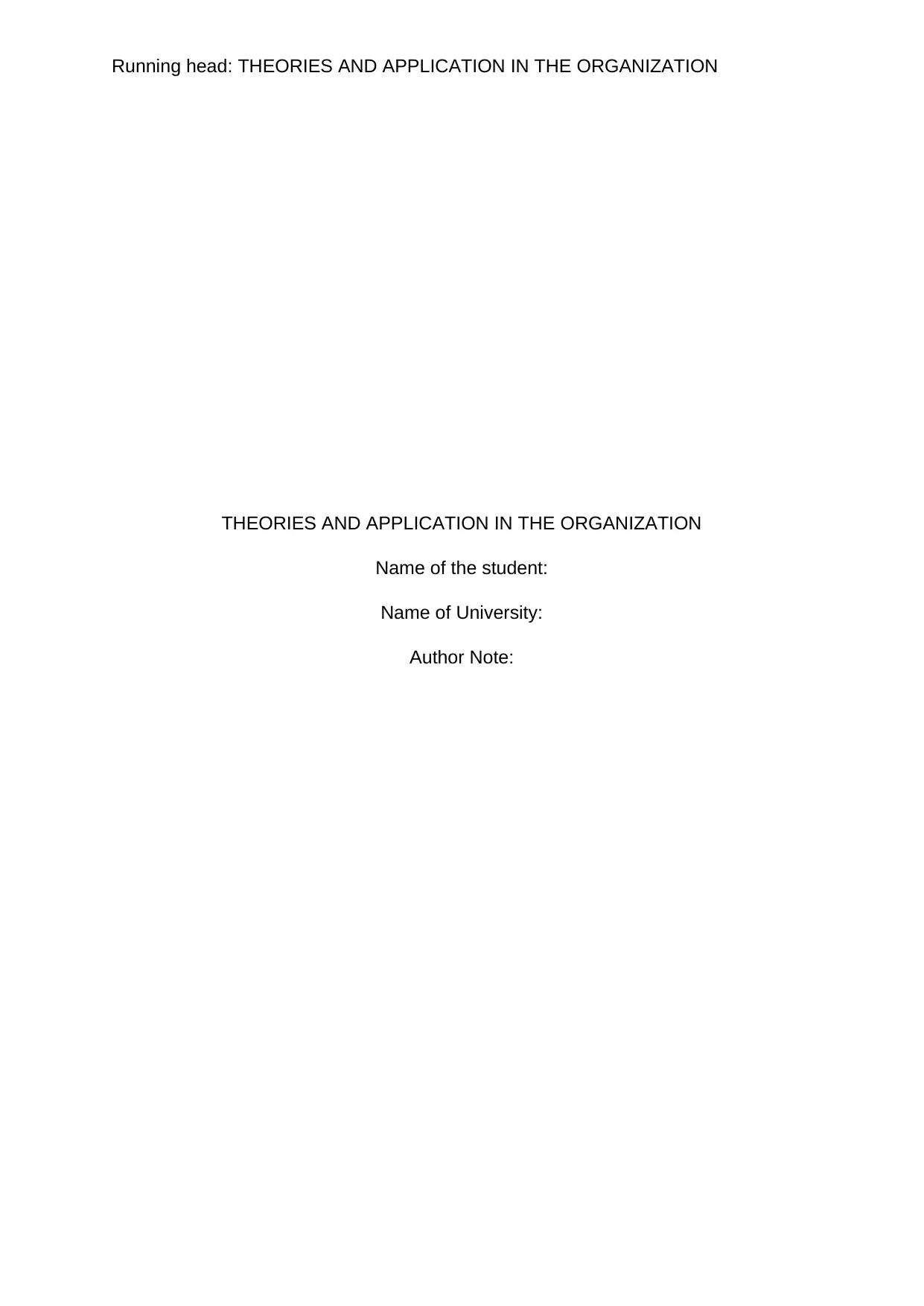
Running head: THEORIES AND APPLICATION IN THE ORGANIZATION
THEORIES AND APPLICATION IN THE ORGANIZATION
Name of the student:
Name of University:
Author Note:
THEORIES AND APPLICATION IN THE ORGANIZATION
Name of the student:
Name of University:
Author Note:
Paraphrase This Document
Need a fresh take? Get an instant paraphrase of this document with our AI Paraphraser
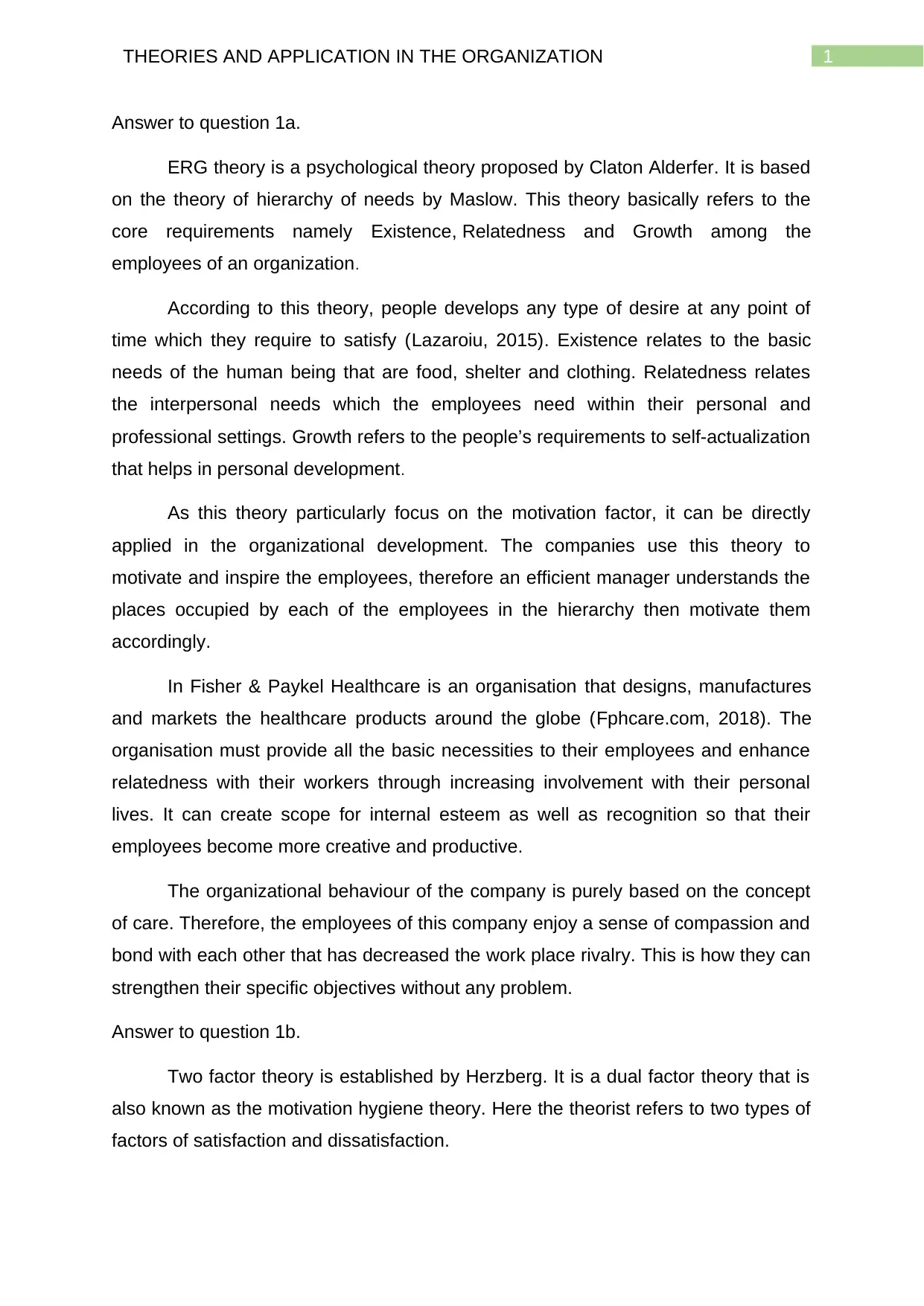
1THEORIES AND APPLICATION IN THE ORGANIZATION
Answer to question 1a.
ERG theory is a psychological theory proposed by Claton Alderfer. It is based
on the theory of hierarchy of needs by Maslow. This theory basically refers to the
core requirements namely Existence, Relatedness and Growth among the
employees of an organization.
According to this theory, people develops any type of desire at any point of
time which they require to satisfy (Lazaroiu, 2015). Existence relates to the basic
needs of the human being that are food, shelter and clothing. Relatedness relates
the interpersonal needs which the employees need within their personal and
professional settings. Growth refers to the people’s requirements to self-actualization
that helps in personal development.
As this theory particularly focus on the motivation factor, it can be directly
applied in the organizational development. The companies use this theory to
motivate and inspire the employees, therefore an efficient manager understands the
places occupied by each of the employees in the hierarchy then motivate them
accordingly.
In Fisher & Paykel Healthcare is an organisation that designs, manufactures
and markets the healthcare products around the globe (Fphcare.com, 2018). The
organisation must provide all the basic necessities to their employees and enhance
relatedness with their workers through increasing involvement with their personal
lives. It can create scope for internal esteem as well as recognition so that their
employees become more creative and productive.
The organizational behaviour of the company is purely based on the concept
of care. Therefore, the employees of this company enjoy a sense of compassion and
bond with each other that has decreased the work place rivalry. This is how they can
strengthen their specific objectives without any problem.
Answer to question 1b.
Two factor theory is established by Herzberg. It is a dual factor theory that is
also known as the motivation hygiene theory. Here the theorist refers to two types of
factors of satisfaction and dissatisfaction.
Answer to question 1a.
ERG theory is a psychological theory proposed by Claton Alderfer. It is based
on the theory of hierarchy of needs by Maslow. This theory basically refers to the
core requirements namely Existence, Relatedness and Growth among the
employees of an organization.
According to this theory, people develops any type of desire at any point of
time which they require to satisfy (Lazaroiu, 2015). Existence relates to the basic
needs of the human being that are food, shelter and clothing. Relatedness relates
the interpersonal needs which the employees need within their personal and
professional settings. Growth refers to the people’s requirements to self-actualization
that helps in personal development.
As this theory particularly focus on the motivation factor, it can be directly
applied in the organizational development. The companies use this theory to
motivate and inspire the employees, therefore an efficient manager understands the
places occupied by each of the employees in the hierarchy then motivate them
accordingly.
In Fisher & Paykel Healthcare is an organisation that designs, manufactures
and markets the healthcare products around the globe (Fphcare.com, 2018). The
organisation must provide all the basic necessities to their employees and enhance
relatedness with their workers through increasing involvement with their personal
lives. It can create scope for internal esteem as well as recognition so that their
employees become more creative and productive.
The organizational behaviour of the company is purely based on the concept
of care. Therefore, the employees of this company enjoy a sense of compassion and
bond with each other that has decreased the work place rivalry. This is how they can
strengthen their specific objectives without any problem.
Answer to question 1b.
Two factor theory is established by Herzberg. It is a dual factor theory that is
also known as the motivation hygiene theory. Here the theorist refers to two types of
factors of satisfaction and dissatisfaction.
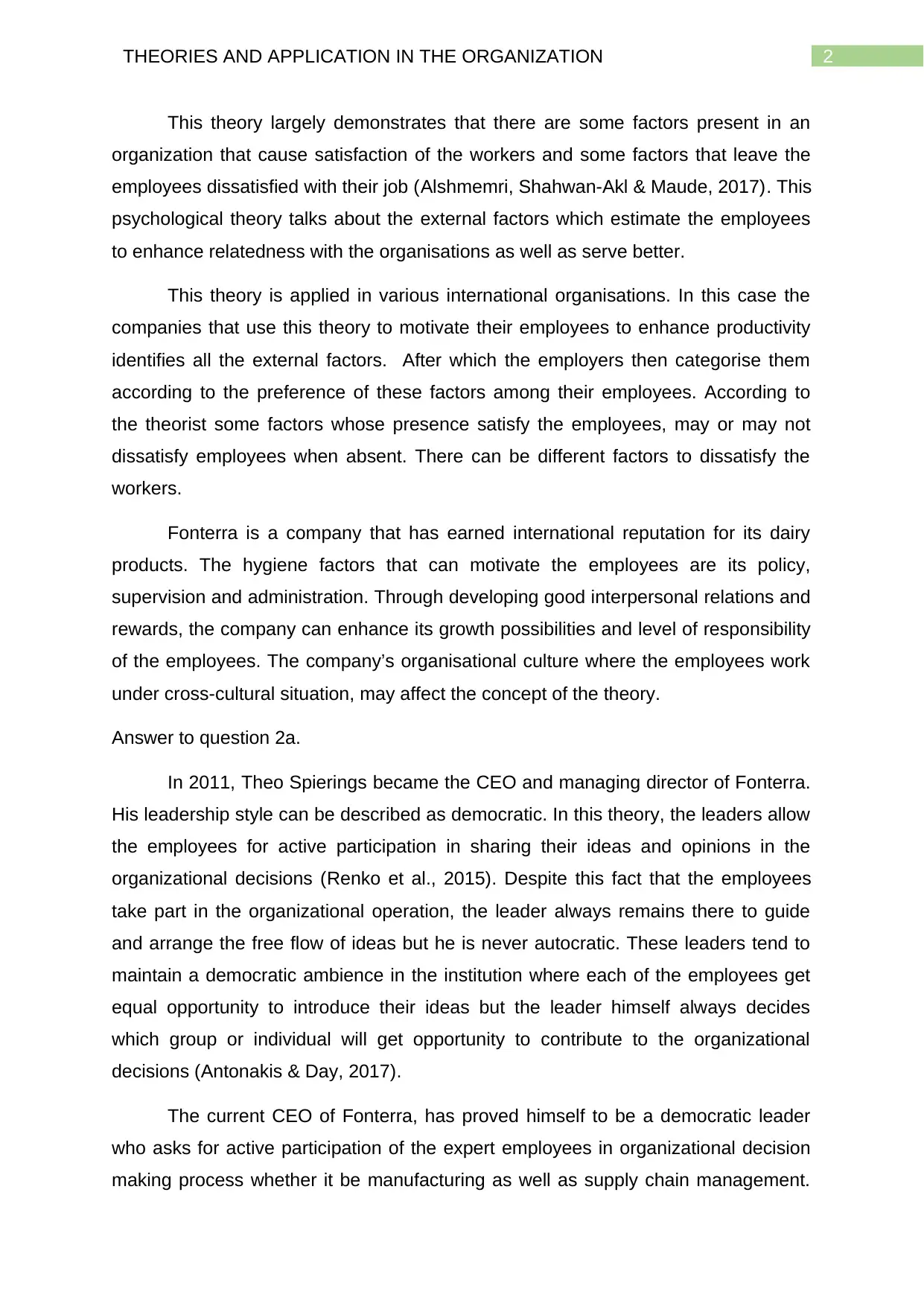
2THEORIES AND APPLICATION IN THE ORGANIZATION
This theory largely demonstrates that there are some factors present in an
organization that cause satisfaction of the workers and some factors that leave the
employees dissatisfied with their job (Alshmemri, Shahwan-Akl & Maude, 2017). This
psychological theory talks about the external factors which estimate the employees
to enhance relatedness with the organisations as well as serve better.
This theory is applied in various international organisations. In this case the
companies that use this theory to motivate their employees to enhance productivity
identifies all the external factors. After which the employers then categorise them
according to the preference of these factors among their employees. According to
the theorist some factors whose presence satisfy the employees, may or may not
dissatisfy employees when absent. There can be different factors to dissatisfy the
workers.
Fonterra is a company that has earned international reputation for its dairy
products. The hygiene factors that can motivate the employees are its policy,
supervision and administration. Through developing good interpersonal relations and
rewards, the company can enhance its growth possibilities and level of responsibility
of the employees. The company’s organisational culture where the employees work
under cross-cultural situation, may affect the concept of the theory.
Answer to question 2a.
In 2011, Theo Spierings became the CEO and managing director of Fonterra.
His leadership style can be described as democratic. In this theory, the leaders allow
the employees for active participation in sharing their ideas and opinions in the
organizational decisions (Renko et al., 2015). Despite this fact that the employees
take part in the organizational operation, the leader always remains there to guide
and arrange the free flow of ideas but he is never autocratic. These leaders tend to
maintain a democratic ambience in the institution where each of the employees get
equal opportunity to introduce their ideas but the leader himself always decides
which group or individual will get opportunity to contribute to the organizational
decisions (Antonakis & Day, 2017).
The current CEO of Fonterra, has proved himself to be a democratic leader
who asks for active participation of the expert employees in organizational decision
making process whether it be manufacturing as well as supply chain management.
This theory largely demonstrates that there are some factors present in an
organization that cause satisfaction of the workers and some factors that leave the
employees dissatisfied with their job (Alshmemri, Shahwan-Akl & Maude, 2017). This
psychological theory talks about the external factors which estimate the employees
to enhance relatedness with the organisations as well as serve better.
This theory is applied in various international organisations. In this case the
companies that use this theory to motivate their employees to enhance productivity
identifies all the external factors. After which the employers then categorise them
according to the preference of these factors among their employees. According to
the theorist some factors whose presence satisfy the employees, may or may not
dissatisfy employees when absent. There can be different factors to dissatisfy the
workers.
Fonterra is a company that has earned international reputation for its dairy
products. The hygiene factors that can motivate the employees are its policy,
supervision and administration. Through developing good interpersonal relations and
rewards, the company can enhance its growth possibilities and level of responsibility
of the employees. The company’s organisational culture where the employees work
under cross-cultural situation, may affect the concept of the theory.
Answer to question 2a.
In 2011, Theo Spierings became the CEO and managing director of Fonterra.
His leadership style can be described as democratic. In this theory, the leaders allow
the employees for active participation in sharing their ideas and opinions in the
organizational decisions (Renko et al., 2015). Despite this fact that the employees
take part in the organizational operation, the leader always remains there to guide
and arrange the free flow of ideas but he is never autocratic. These leaders tend to
maintain a democratic ambience in the institution where each of the employees get
equal opportunity to introduce their ideas but the leader himself always decides
which group or individual will get opportunity to contribute to the organizational
decisions (Antonakis & Day, 2017).
The current CEO of Fonterra, has proved himself to be a democratic leader
who asks for active participation of the expert employees in organizational decision
making process whether it be manufacturing as well as supply chain management.
⊘ This is a preview!⊘
Do you want full access?
Subscribe today to unlock all pages.

Trusted by 1+ million students worldwide
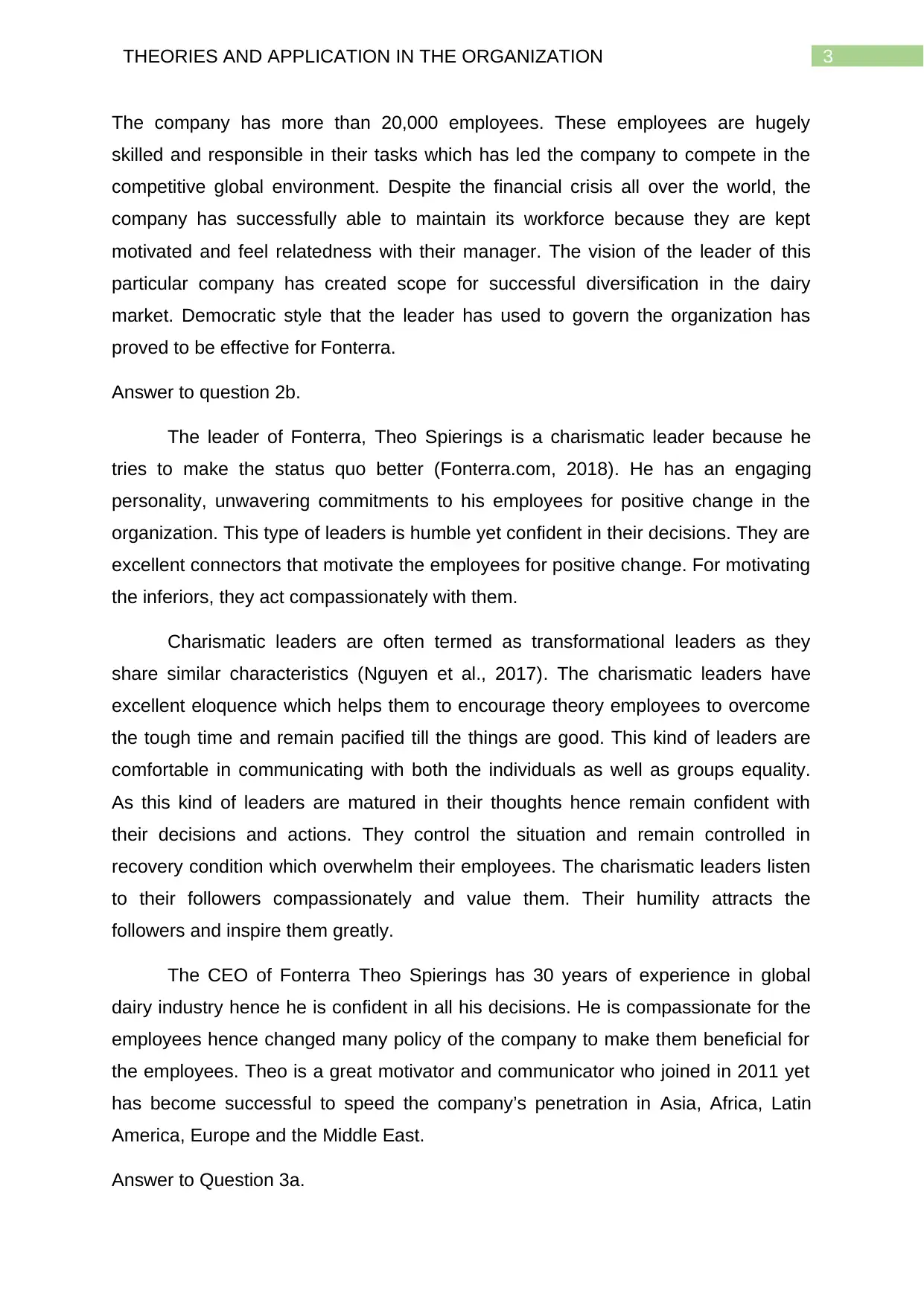
3THEORIES AND APPLICATION IN THE ORGANIZATION
The company has more than 20,000 employees. These employees are hugely
skilled and responsible in their tasks which has led the company to compete in the
competitive global environment. Despite the financial crisis all over the world, the
company has successfully able to maintain its workforce because they are kept
motivated and feel relatedness with their manager. The vision of the leader of this
particular company has created scope for successful diversification in the dairy
market. Democratic style that the leader has used to govern the organization has
proved to be effective for Fonterra.
Answer to question 2b.
The leader of Fonterra, Theo Spierings is a charismatic leader because he
tries to make the status quo better (Fonterra.com, 2018). He has an engaging
personality, unwavering commitments to his employees for positive change in the
organization. This type of leaders is humble yet confident in their decisions. They are
excellent connectors that motivate the employees for positive change. For motivating
the inferiors, they act compassionately with them.
Charismatic leaders are often termed as transformational leaders as they
share similar characteristics (Nguyen et al., 2017). The charismatic leaders have
excellent eloquence which helps them to encourage theory employees to overcome
the tough time and remain pacified till the things are good. This kind of leaders are
comfortable in communicating with both the individuals as well as groups equality.
As this kind of leaders are matured in their thoughts hence remain confident with
their decisions and actions. They control the situation and remain controlled in
recovery condition which overwhelm their employees. The charismatic leaders listen
to their followers compassionately and value them. Their humility attracts the
followers and inspire them greatly.
The CEO of Fonterra Theo Spierings has 30 years of experience in global
dairy industry hence he is confident in all his decisions. He is compassionate for the
employees hence changed many policy of the company to make them beneficial for
the employees. Theo is a great motivator and communicator who joined in 2011 yet
has become successful to speed the company’s penetration in Asia, Africa, Latin
America, Europe and the Middle East.
Answer to Question 3a.
The company has more than 20,000 employees. These employees are hugely
skilled and responsible in their tasks which has led the company to compete in the
competitive global environment. Despite the financial crisis all over the world, the
company has successfully able to maintain its workforce because they are kept
motivated and feel relatedness with their manager. The vision of the leader of this
particular company has created scope for successful diversification in the dairy
market. Democratic style that the leader has used to govern the organization has
proved to be effective for Fonterra.
Answer to question 2b.
The leader of Fonterra, Theo Spierings is a charismatic leader because he
tries to make the status quo better (Fonterra.com, 2018). He has an engaging
personality, unwavering commitments to his employees for positive change in the
organization. This type of leaders is humble yet confident in their decisions. They are
excellent connectors that motivate the employees for positive change. For motivating
the inferiors, they act compassionately with them.
Charismatic leaders are often termed as transformational leaders as they
share similar characteristics (Nguyen et al., 2017). The charismatic leaders have
excellent eloquence which helps them to encourage theory employees to overcome
the tough time and remain pacified till the things are good. This kind of leaders are
comfortable in communicating with both the individuals as well as groups equality.
As this kind of leaders are matured in their thoughts hence remain confident with
their decisions and actions. They control the situation and remain controlled in
recovery condition which overwhelm their employees. The charismatic leaders listen
to their followers compassionately and value them. Their humility attracts the
followers and inspire them greatly.
The CEO of Fonterra Theo Spierings has 30 years of experience in global
dairy industry hence he is confident in all his decisions. He is compassionate for the
employees hence changed many policy of the company to make them beneficial for
the employees. Theo is a great motivator and communicator who joined in 2011 yet
has become successful to speed the company’s penetration in Asia, Africa, Latin
America, Europe and the Middle East.
Answer to Question 3a.
Paraphrase This Document
Need a fresh take? Get an instant paraphrase of this document with our AI Paraphraser
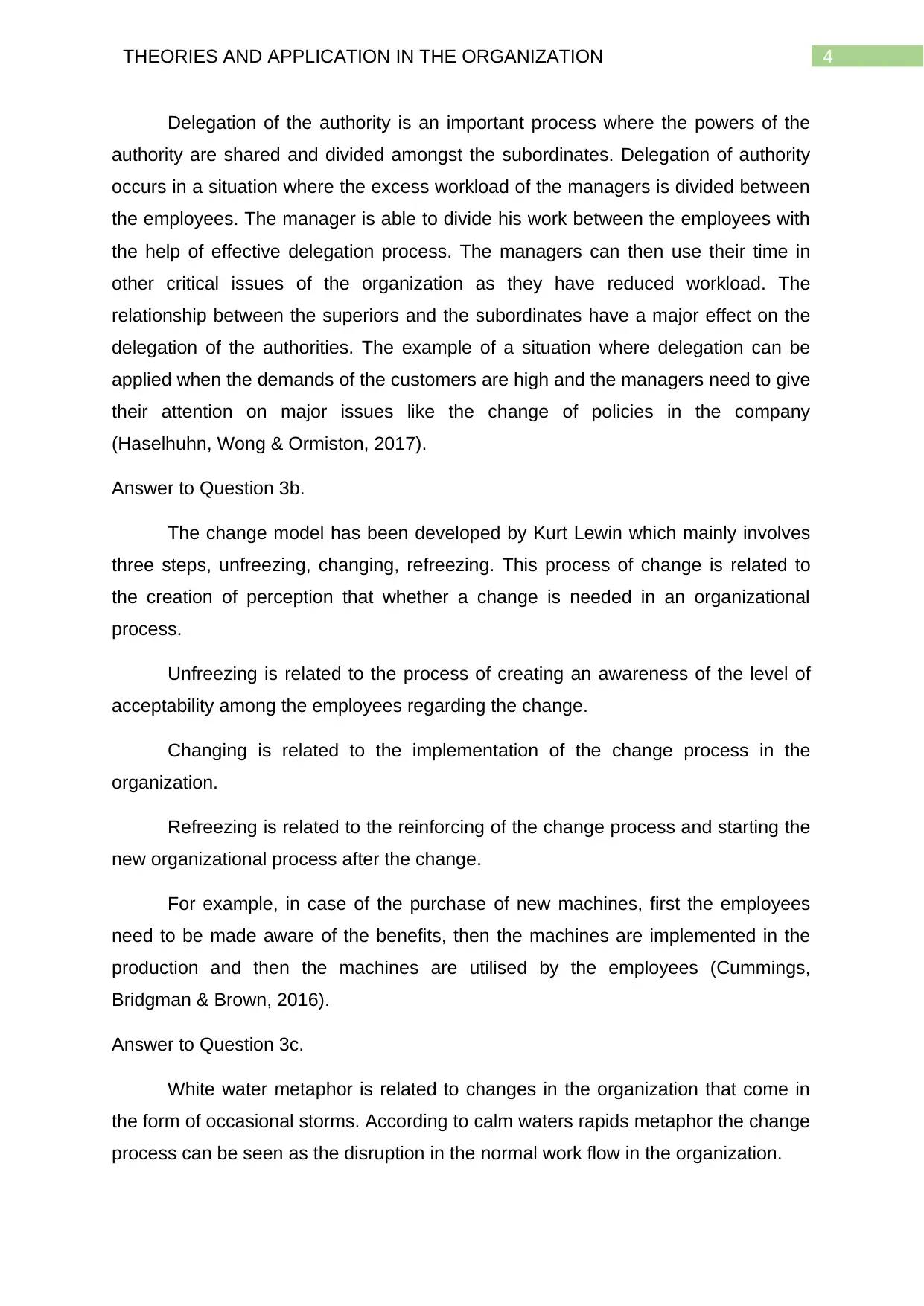
4THEORIES AND APPLICATION IN THE ORGANIZATION
Delegation of the authority is an important process where the powers of the
authority are shared and divided amongst the subordinates. Delegation of authority
occurs in a situation where the excess workload of the managers is divided between
the employees. The manager is able to divide his work between the employees with
the help of effective delegation process. The managers can then use their time in
other critical issues of the organization as they have reduced workload. The
relationship between the superiors and the subordinates have a major effect on the
delegation of the authorities. The example of a situation where delegation can be
applied when the demands of the customers are high and the managers need to give
their attention on major issues like the change of policies in the company
(Haselhuhn, Wong & Ormiston, 2017).
Answer to Question 3b.
The change model has been developed by Kurt Lewin which mainly involves
three steps, unfreezing, changing, refreezing. This process of change is related to
the creation of perception that whether a change is needed in an organizational
process.
Unfreezing is related to the process of creating an awareness of the level of
acceptability among the employees regarding the change.
Changing is related to the implementation of the change process in the
organization.
Refreezing is related to the reinforcing of the change process and starting the
new organizational process after the change.
For example, in case of the purchase of new machines, first the employees
need to be made aware of the benefits, then the machines are implemented in the
production and then the machines are utilised by the employees (Cummings,
Bridgman & Brown, 2016).
Answer to Question 3c.
White water metaphor is related to changes in the organization that come in
the form of occasional storms. According to calm waters rapids metaphor the change
process can be seen as the disruption in the normal work flow in the organization.
Delegation of the authority is an important process where the powers of the
authority are shared and divided amongst the subordinates. Delegation of authority
occurs in a situation where the excess workload of the managers is divided between
the employees. The manager is able to divide his work between the employees with
the help of effective delegation process. The managers can then use their time in
other critical issues of the organization as they have reduced workload. The
relationship between the superiors and the subordinates have a major effect on the
delegation of the authorities. The example of a situation where delegation can be
applied when the demands of the customers are high and the managers need to give
their attention on major issues like the change of policies in the company
(Haselhuhn, Wong & Ormiston, 2017).
Answer to Question 3b.
The change model has been developed by Kurt Lewin which mainly involves
three steps, unfreezing, changing, refreezing. This process of change is related to
the creation of perception that whether a change is needed in an organizational
process.
Unfreezing is related to the process of creating an awareness of the level of
acceptability among the employees regarding the change.
Changing is related to the implementation of the change process in the
organization.
Refreezing is related to the reinforcing of the change process and starting the
new organizational process after the change.
For example, in case of the purchase of new machines, first the employees
need to be made aware of the benefits, then the machines are implemented in the
production and then the machines are utilised by the employees (Cummings,
Bridgman & Brown, 2016).
Answer to Question 3c.
White water metaphor is related to changes in the organization that come in
the form of occasional storms. According to calm waters rapids metaphor the change
process can be seen as the disruption in the normal work flow in the organization.
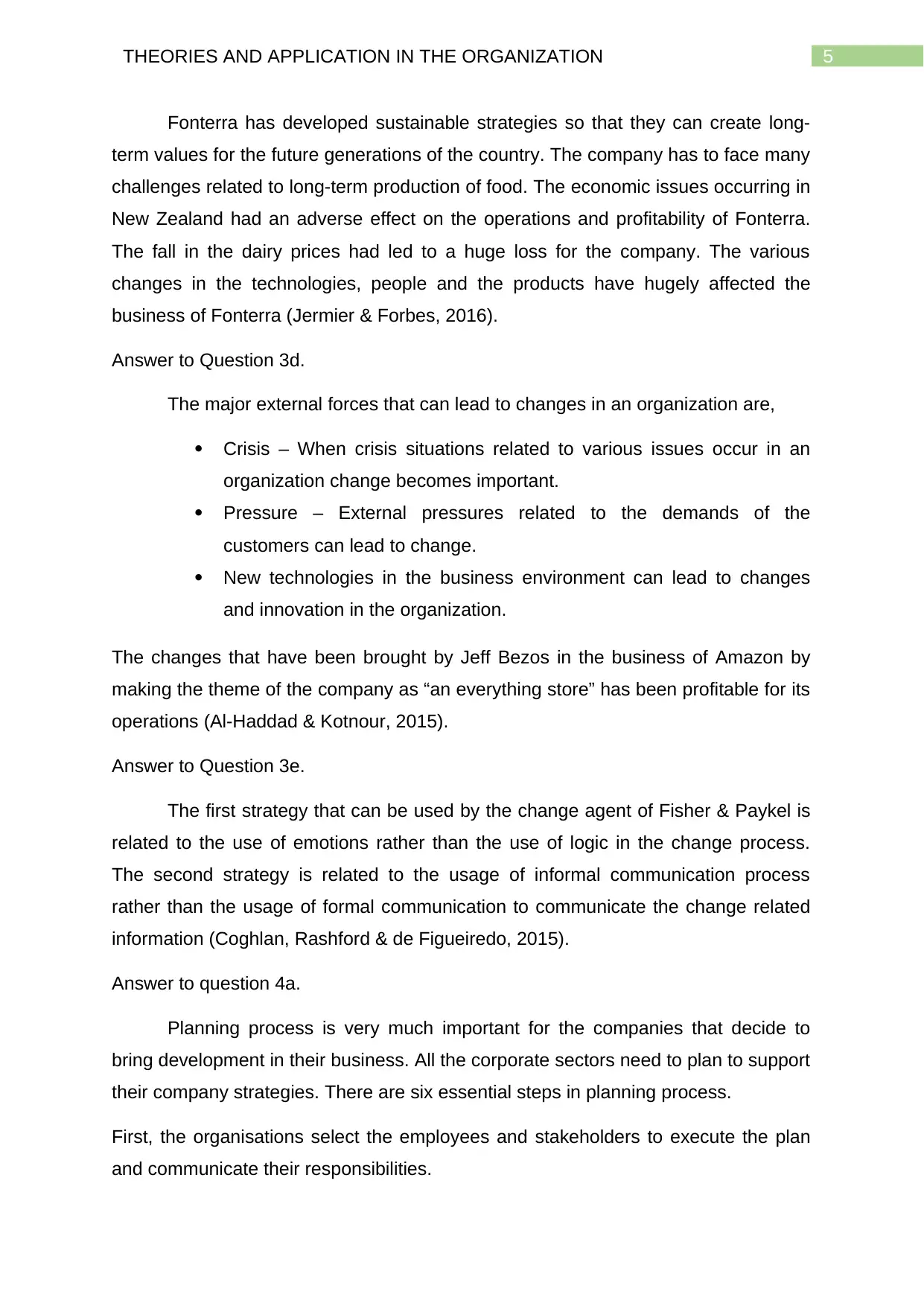
5THEORIES AND APPLICATION IN THE ORGANIZATION
Fonterra has developed sustainable strategies so that they can create long-
term values for the future generations of the country. The company has to face many
challenges related to long-term production of food. The economic issues occurring in
New Zealand had an adverse effect on the operations and profitability of Fonterra.
The fall in the dairy prices had led to a huge loss for the company. The various
changes in the technologies, people and the products have hugely affected the
business of Fonterra (Jermier & Forbes, 2016).
Answer to Question 3d.
The major external forces that can lead to changes in an organization are,
Crisis – When crisis situations related to various issues occur in an
organization change becomes important.
Pressure – External pressures related to the demands of the
customers can lead to change.
New technologies in the business environment can lead to changes
and innovation in the organization.
The changes that have been brought by Jeff Bezos in the business of Amazon by
making the theme of the company as “an everything store” has been profitable for its
operations (Al-Haddad & Kotnour, 2015).
Answer to Question 3e.
The first strategy that can be used by the change agent of Fisher & Paykel is
related to the use of emotions rather than the use of logic in the change process.
The second strategy is related to the usage of informal communication process
rather than the usage of formal communication to communicate the change related
information (Coghlan, Rashford & de Figueiredo, 2015).
Answer to question 4a.
Planning process is very much important for the companies that decide to
bring development in their business. All the corporate sectors need to plan to support
their company strategies. There are six essential steps in planning process.
First, the organisations select the employees and stakeholders to execute the plan
and communicate their responsibilities.
Fonterra has developed sustainable strategies so that they can create long-
term values for the future generations of the country. The company has to face many
challenges related to long-term production of food. The economic issues occurring in
New Zealand had an adverse effect on the operations and profitability of Fonterra.
The fall in the dairy prices had led to a huge loss for the company. The various
changes in the technologies, people and the products have hugely affected the
business of Fonterra (Jermier & Forbes, 2016).
Answer to Question 3d.
The major external forces that can lead to changes in an organization are,
Crisis – When crisis situations related to various issues occur in an
organization change becomes important.
Pressure – External pressures related to the demands of the
customers can lead to change.
New technologies in the business environment can lead to changes
and innovation in the organization.
The changes that have been brought by Jeff Bezos in the business of Amazon by
making the theme of the company as “an everything store” has been profitable for its
operations (Al-Haddad & Kotnour, 2015).
Answer to Question 3e.
The first strategy that can be used by the change agent of Fisher & Paykel is
related to the use of emotions rather than the use of logic in the change process.
The second strategy is related to the usage of informal communication process
rather than the usage of formal communication to communicate the change related
information (Coghlan, Rashford & de Figueiredo, 2015).
Answer to question 4a.
Planning process is very much important for the companies that decide to
bring development in their business. All the corporate sectors need to plan to support
their company strategies. There are six essential steps in planning process.
First, the organisations select the employees and stakeholders to execute the plan
and communicate their responsibilities.
⊘ This is a preview!⊘
Do you want full access?
Subscribe today to unlock all pages.

Trusted by 1+ million students worldwide
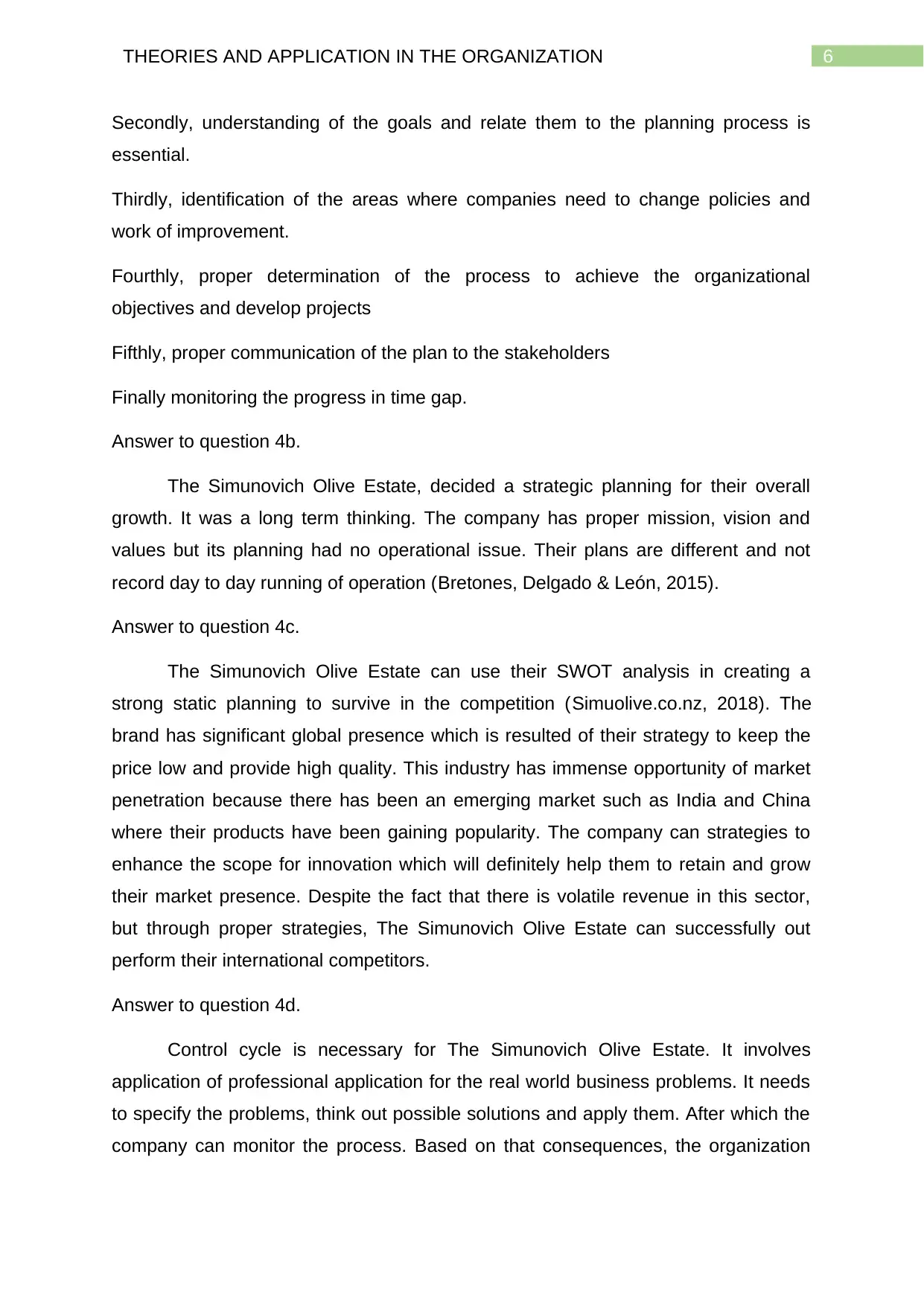
6THEORIES AND APPLICATION IN THE ORGANIZATION
Secondly, understanding of the goals and relate them to the planning process is
essential.
Thirdly, identification of the areas where companies need to change policies and
work of improvement.
Fourthly, proper determination of the process to achieve the organizational
objectives and develop projects
Fifthly, proper communication of the plan to the stakeholders
Finally monitoring the progress in time gap.
Answer to question 4b.
The Simunovich Olive Estate, decided a strategic planning for their overall
growth. It was a long term thinking. The company has proper mission, vision and
values but its planning had no operational issue. Their plans are different and not
record day to day running of operation (Bretones, Delgado & León, 2015).
Answer to question 4c.
The Simunovich Olive Estate can use their SWOT analysis in creating a
strong static planning to survive in the competition (Simuolive.co.nz, 2018). The
brand has significant global presence which is resulted of their strategy to keep the
price low and provide high quality. This industry has immense opportunity of market
penetration because there has been an emerging market such as India and China
where their products have been gaining popularity. The company can strategies to
enhance the scope for innovation which will definitely help them to retain and grow
their market presence. Despite the fact that there is volatile revenue in this sector,
but through proper strategies, The Simunovich Olive Estate can successfully out
perform their international competitors.
Answer to question 4d.
Control cycle is necessary for The Simunovich Olive Estate. It involves
application of professional application for the real world business problems. It needs
to specify the problems, think out possible solutions and apply them. After which the
company can monitor the process. Based on that consequences, the organization
Secondly, understanding of the goals and relate them to the planning process is
essential.
Thirdly, identification of the areas where companies need to change policies and
work of improvement.
Fourthly, proper determination of the process to achieve the organizational
objectives and develop projects
Fifthly, proper communication of the plan to the stakeholders
Finally monitoring the progress in time gap.
Answer to question 4b.
The Simunovich Olive Estate, decided a strategic planning for their overall
growth. It was a long term thinking. The company has proper mission, vision and
values but its planning had no operational issue. Their plans are different and not
record day to day running of operation (Bretones, Delgado & León, 2015).
Answer to question 4c.
The Simunovich Olive Estate can use their SWOT analysis in creating a
strong static planning to survive in the competition (Simuolive.co.nz, 2018). The
brand has significant global presence which is resulted of their strategy to keep the
price low and provide high quality. This industry has immense opportunity of market
penetration because there has been an emerging market such as India and China
where their products have been gaining popularity. The company can strategies to
enhance the scope for innovation which will definitely help them to retain and grow
their market presence. Despite the fact that there is volatile revenue in this sector,
but through proper strategies, The Simunovich Olive Estate can successfully out
perform their international competitors.
Answer to question 4d.
Control cycle is necessary for The Simunovich Olive Estate. It involves
application of professional application for the real world business problems. It needs
to specify the problems, think out possible solutions and apply them. After which the
company can monitor the process. Based on that consequences, the organization
Paraphrase This Document
Need a fresh take? Get an instant paraphrase of this document with our AI Paraphraser
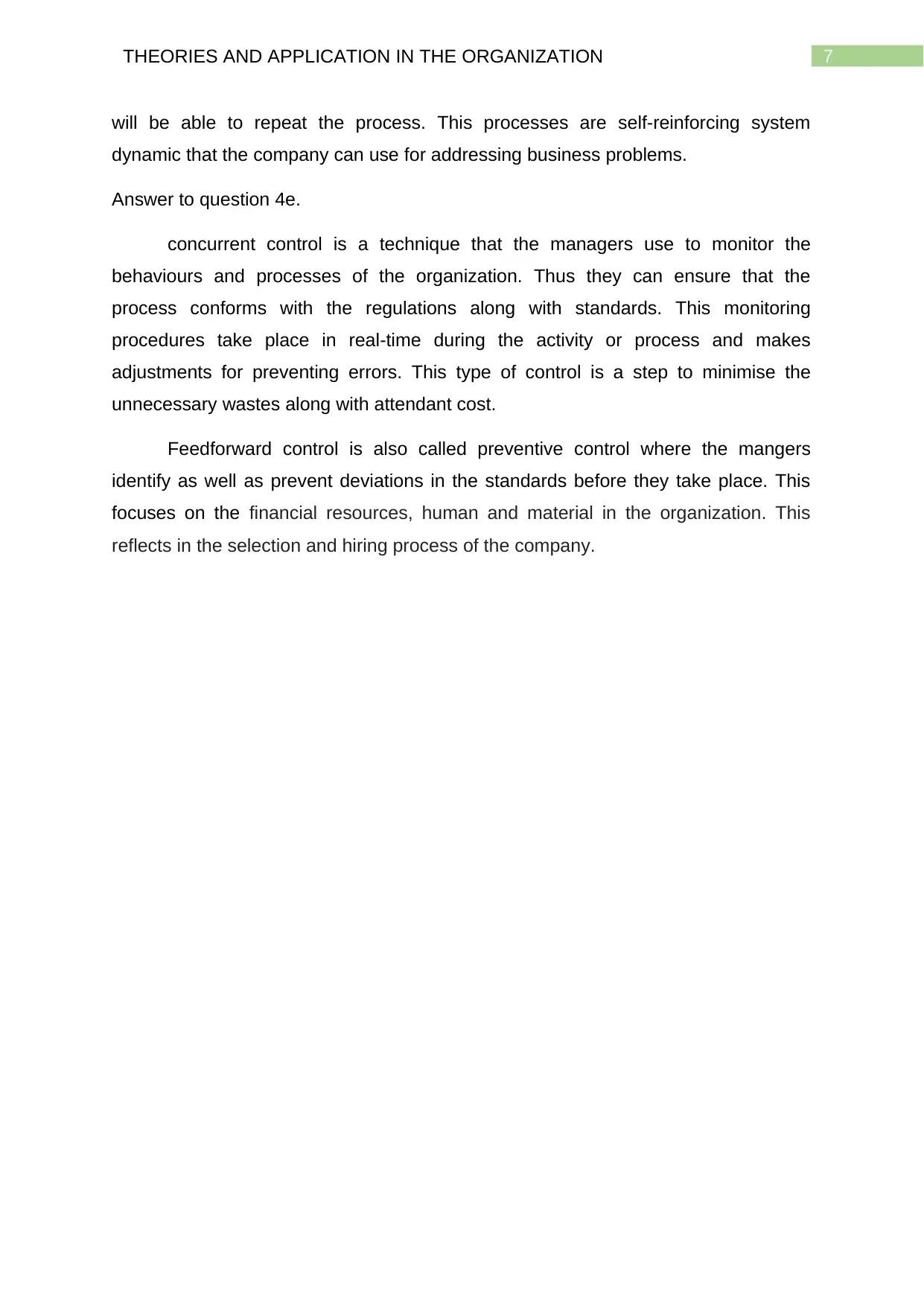
7THEORIES AND APPLICATION IN THE ORGANIZATION
will be able to repeat the process. This processes are self-reinforcing system
dynamic that the company can use for addressing business problems.
Answer to question 4e.
concurrent control is a technique that the managers use to monitor the
behaviours and processes of the organization. Thus they can ensure that the
process conforms with the regulations along with standards. This monitoring
procedures take place in real-time during the activity or process and makes
adjustments for preventing errors. This type of control is a step to minimise the
unnecessary wastes along with attendant cost.
Feedforward control is also called preventive control where the mangers
identify as well as prevent deviations in the standards before they take place. This
focuses on the financial resources, human and material in the organization. This
reflects in the selection and hiring process of the company.
will be able to repeat the process. This processes are self-reinforcing system
dynamic that the company can use for addressing business problems.
Answer to question 4e.
concurrent control is a technique that the managers use to monitor the
behaviours and processes of the organization. Thus they can ensure that the
process conforms with the regulations along with standards. This monitoring
procedures take place in real-time during the activity or process and makes
adjustments for preventing errors. This type of control is a step to minimise the
unnecessary wastes along with attendant cost.
Feedforward control is also called preventive control where the mangers
identify as well as prevent deviations in the standards before they take place. This
focuses on the financial resources, human and material in the organization. This
reflects in the selection and hiring process of the company.
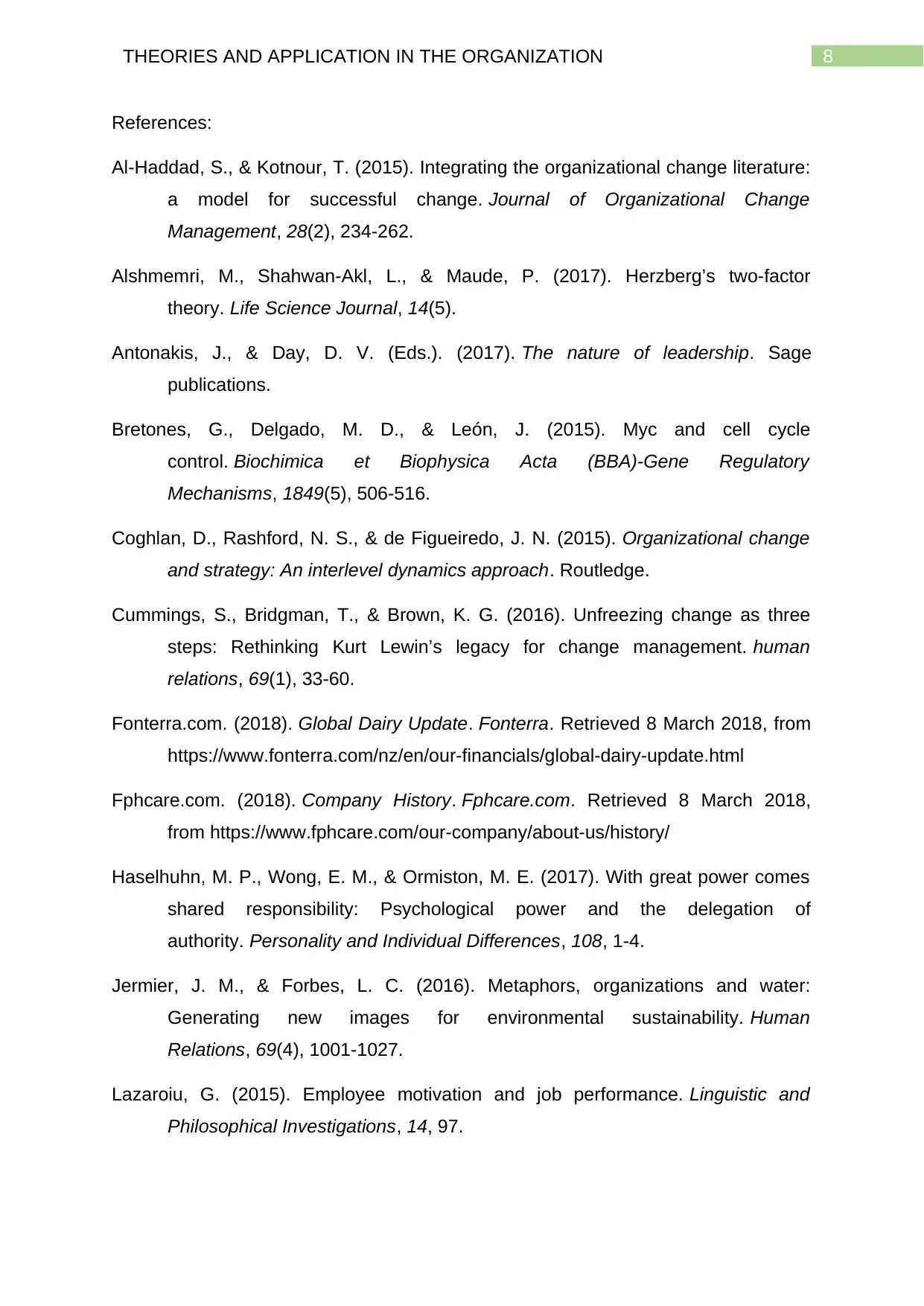
8THEORIES AND APPLICATION IN THE ORGANIZATION
References:
Al-Haddad, S., & Kotnour, T. (2015). Integrating the organizational change literature:
a model for successful change. Journal of Organizational Change
Management, 28(2), 234-262.
Alshmemri, M., Shahwan-Akl, L., & Maude, P. (2017). Herzberg’s two-factor
theory. Life Science Journal, 14(5).
Antonakis, J., & Day, D. V. (Eds.). (2017). The nature of leadership. Sage
publications.
Bretones, G., Delgado, M. D., & León, J. (2015). Myc and cell cycle
control. Biochimica et Biophysica Acta (BBA)-Gene Regulatory
Mechanisms, 1849(5), 506-516.
Coghlan, D., Rashford, N. S., & de Figueiredo, J. N. (2015). Organizational change
and strategy: An interlevel dynamics approach. Routledge.
Cummings, S., Bridgman, T., & Brown, K. G. (2016). Unfreezing change as three
steps: Rethinking Kurt Lewin’s legacy for change management. human
relations, 69(1), 33-60.
Fonterra.com. (2018). Global Dairy Update. Fonterra. Retrieved 8 March 2018, from
https://www.fonterra.com/nz/en/our-financials/global-dairy-update.html
Fphcare.com. (2018). Company History. Fphcare.com. Retrieved 8 March 2018,
from https://www.fphcare.com/our-company/about-us/history/
Haselhuhn, M. P., Wong, E. M., & Ormiston, M. E. (2017). With great power comes
shared responsibility: Psychological power and the delegation of
authority. Personality and Individual Differences, 108, 1-4.
Jermier, J. M., & Forbes, L. C. (2016). Metaphors, organizations and water:
Generating new images for environmental sustainability. Human
Relations, 69(4), 1001-1027.
Lazaroiu, G. (2015). Employee motivation and job performance. Linguistic and
Philosophical Investigations, 14, 97.
References:
Al-Haddad, S., & Kotnour, T. (2015). Integrating the organizational change literature:
a model for successful change. Journal of Organizational Change
Management, 28(2), 234-262.
Alshmemri, M., Shahwan-Akl, L., & Maude, P. (2017). Herzberg’s two-factor
theory. Life Science Journal, 14(5).
Antonakis, J., & Day, D. V. (Eds.). (2017). The nature of leadership. Sage
publications.
Bretones, G., Delgado, M. D., & León, J. (2015). Myc and cell cycle
control. Biochimica et Biophysica Acta (BBA)-Gene Regulatory
Mechanisms, 1849(5), 506-516.
Coghlan, D., Rashford, N. S., & de Figueiredo, J. N. (2015). Organizational change
and strategy: An interlevel dynamics approach. Routledge.
Cummings, S., Bridgman, T., & Brown, K. G. (2016). Unfreezing change as three
steps: Rethinking Kurt Lewin’s legacy for change management. human
relations, 69(1), 33-60.
Fonterra.com. (2018). Global Dairy Update. Fonterra. Retrieved 8 March 2018, from
https://www.fonterra.com/nz/en/our-financials/global-dairy-update.html
Fphcare.com. (2018). Company History. Fphcare.com. Retrieved 8 March 2018,
from https://www.fphcare.com/our-company/about-us/history/
Haselhuhn, M. P., Wong, E. M., & Ormiston, M. E. (2017). With great power comes
shared responsibility: Psychological power and the delegation of
authority. Personality and Individual Differences, 108, 1-4.
Jermier, J. M., & Forbes, L. C. (2016). Metaphors, organizations and water:
Generating new images for environmental sustainability. Human
Relations, 69(4), 1001-1027.
Lazaroiu, G. (2015). Employee motivation and job performance. Linguistic and
Philosophical Investigations, 14, 97.
⊘ This is a preview!⊘
Do you want full access?
Subscribe today to unlock all pages.

Trusted by 1+ million students worldwide
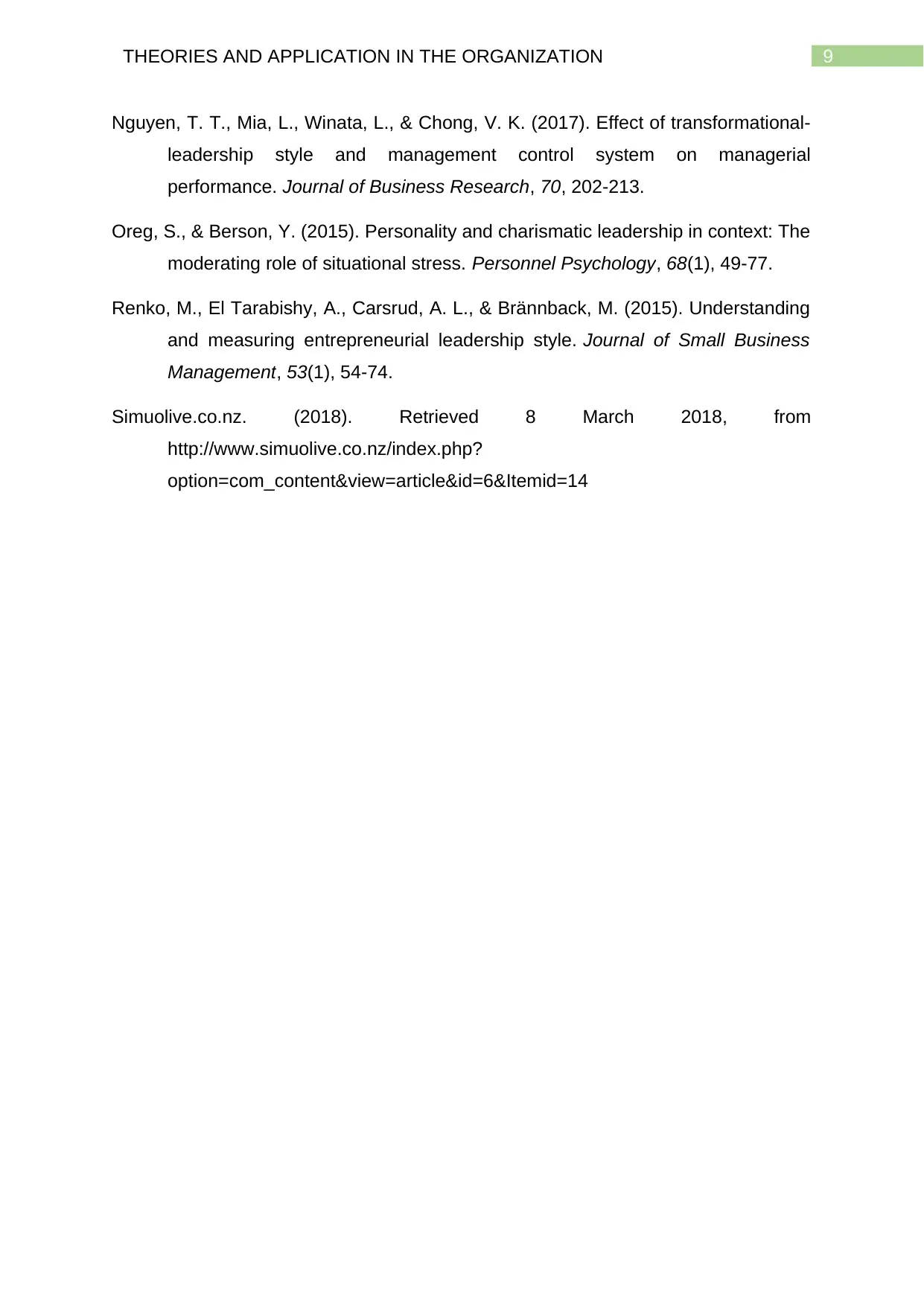
9THEORIES AND APPLICATION IN THE ORGANIZATION
Nguyen, T. T., Mia, L., Winata, L., & Chong, V. K. (2017). Effect of transformational-
leadership style and management control system on managerial
performance. Journal of Business Research, 70, 202-213.
Oreg, S., & Berson, Y. (2015). Personality and charismatic leadership in context: The
moderating role of situational stress. Personnel Psychology, 68(1), 49-77.
Renko, M., El Tarabishy, A., Carsrud, A. L., & Brännback, M. (2015). Understanding
and measuring entrepreneurial leadership style. Journal of Small Business
Management, 53(1), 54-74.
Simuolive.co.nz. (2018). Retrieved 8 March 2018, from
http://www.simuolive.co.nz/index.php?
option=com_content&view=article&id=6&Itemid=14
Nguyen, T. T., Mia, L., Winata, L., & Chong, V. K. (2017). Effect of transformational-
leadership style and management control system on managerial
performance. Journal of Business Research, 70, 202-213.
Oreg, S., & Berson, Y. (2015). Personality and charismatic leadership in context: The
moderating role of situational stress. Personnel Psychology, 68(1), 49-77.
Renko, M., El Tarabishy, A., Carsrud, A. L., & Brännback, M. (2015). Understanding
and measuring entrepreneurial leadership style. Journal of Small Business
Management, 53(1), 54-74.
Simuolive.co.nz. (2018). Retrieved 8 March 2018, from
http://www.simuolive.co.nz/index.php?
option=com_content&view=article&id=6&Itemid=14
1 out of 10
Related Documents
Your All-in-One AI-Powered Toolkit for Academic Success.
+13062052269
info@desklib.com
Available 24*7 on WhatsApp / Email
![[object Object]](/_next/static/media/star-bottom.7253800d.svg)
Unlock your academic potential
Copyright © 2020–2025 A2Z Services. All Rights Reserved. Developed and managed by ZUCOL.




